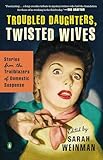The headline says it all: “Girl Who Was Kidnaped [sic] at 11 Killed at 15 in Auto Crash.” The newspaper article, dateline Woodbine, N.J., goes on to report: “Florence (Sally) Horner, 15, the victim in a bizarre kidnapping case a few years ago, was killed in an automobile accident yesterday on the Woodbine-Dennisville road.” “Yesterday” was around midnight on August 17, 1952.
In her thoroughly researched The Real Lolita, Sarah Weinman proposes that Sally Horner was the inspiration for Dolores Haze (a.k.a. Lolita) in Vladimir Nabokov’s masterwork, Lolita, a novel that has endured for more than 60 years.
Does it really matter? What if the young girl from Camden was the model for the nymphet from Ramsdale? Who was Sally Horner? Who is Dolores Haze? Does one person illuminate or eliminate the other? Does it make any difference in reading the novel?
These are just a few of the tantalizing questions raised by Weinman’s evocative literary detection. Arguably she has done exhaustive research. But to what end? And for what purpose?
 Weinman carries some serious pedigree in the world of crime fiction. She edited two volumes about women writers and domestic suspense—Women Crime Writers: Eight Suspense Novels of the 1940s & 50s and Troubled Daughters, Twisted Wives: Stories from Trailblazers of Domestic Suspense. Like all good scholars she likes subtitles.
Weinman carries some serious pedigree in the world of crime fiction. She edited two volumes about women writers and domestic suspense—Women Crime Writers: Eight Suspense Novels of the 1940s & 50s and Troubled Daughters, Twisted Wives: Stories from Trailblazers of Domestic Suspense. Like all good scholars she likes subtitles.
In this case, the subtitle—“The Kidnapping of Sally Horner and the Novel That Scandalized the World—promises more than the book can deliver. Sally Horner’s kidnapping was real. Lolita’s kidnapping is fiction. And Dolores Haze rose from the imaginative mind of her creator.
Weinman takes as her impetus a parenthetical aside late in the novel. The narrator, Humbert Humbert, conjectures, “(Had I done to Dolly, perhaps, what Frank Lasalle, a fifty-year old mechanic, had done to eleven-year-old Sally Horner in 1948?).” In the context of the novel, the sentence hardly bears rereading. It seems an intrusion into the narrative. Out of context, it conflates a historic event with a fabricated one. But, who was Frank Lasalle? And what does he—the person who kidnapped the real-life Sally—have to do with Lolita or Lolita to do with him?
The first fact reported about Sally Horner in the opening pages of The Real Lolita is a childhood incident that connects her to Frank Lasalle. On a dare from friends in the fifth grade, and wanting to be a part of their group, Sally steals a five-cent notebook from a Woolworth’s in Camden, N.J., in March 1948. She’s unaware that she’s being watched by a middle-aged man. When he accosts her, he claims to be an FBI agent. He says he is going to arrest her but will let her go if she agrees “to report to him from time to time.”
That man turns out to be Lasalle (a.k.a. Frank Warner), a convicted sex offender who had just been released after “serving a sentence for statutory rape of five girls between the ages of twelve and fourteen.” The petty crime and subsequent encounter define the remainder of Sally’s short, tragic life.
While it’s important to recognize the facts about Sally Horner, Weinman also relies on conjecture, often based on second-hand information from friends or acquaintances of Sally to fill the gaps of her speculative narrative. This mixing of fact and conjecture mutes the overall effect of her argument.
What is known is the circuitous path that Sally and Lasalle took across America beginning on June 14, 1948, starting with a bus ride to Atlantic City. They quickly left the shore town and headed to Baltimore, Maryland, which they left by early 1949, heading to Dallas, Texas, where Lasalle claimed the FBI has reassigned him. Eventually the pair end up in a trailer park in San Jose, California, having passed through Oklahoma, New Mexico, Arizona, and Southern California. The itinerary is noteworthy because it shadows the kind of drives across the U.S. that Nabokov often took with his wife, Vera, and their young son, Dmitri.
In her effort to link Sally to Lolita and Nabokov, Weinman establishes a parallel chronology focusing on the writer’s academic, personal, and creative life. Of the book’s 29 chapters eight detail Nabokov’s 20-year struggle to complete his novel, speculate about how he might have learned about Sally, and outline his efforts to publish what would become a notorious piece of fiction.
The assertion that Dolores is based on Sally is pure conjecture. Granted their ages and their cross-country treks are similar. But everything about the essence of Sally’s road trips is speculative.
In his search for butterflies, Nabokov (usually during summer breaks from teaching at Wellesley, Cornell, and Harvard), took his family (first in 1941 in a new Pontiac; later, in a used Oldsmobile) from the East to the West Coast. Once to a 10-day writers’ conference in Salt Lake City, Utah, by way of the Great Lakes, Iowa, and Nebraska, then to the Grand Tetons of Wyoming and West Yellowstone in Montana. A drive in 1953 went from Ithaca, New York, to Birmingham, Alabama, to Arizona, past California lakes, ending in Ashland, Oregon.
Those trips manifest themselves in the novel in memorable chapters that capture the nature of the late 1940s, with Nabokov satirizing details of Americana. With his tongue firmly planted in his cheek, he describes “the Functional Motel—clean, neat, safe nooks,” the “stone cottages under enormous Chateaubriandesque trees,” the “Tourist Homes, country cousins of Funeral ones.” He provides the “repetitious names” of the various “Sunset Motels, U-Beam Cottages, Hillcrest Courts, Mountain View Courts, Green Acres” made of “the brick unit, the adobe unit, the stucco court.”
Along their route Humbert Humbert notes that he and Lolita frequent the “whole gamut” of roadside restaurants “from the lowly Eat with its deer head [and] one half of a chocolate cake under glass” to the “more expensive place with subdued lights, preposterously poor table linen…and an orchestra of zoot-suiters with trumpets.” Nothing like this is recorded in Lasalle and Horner’s real-life journey—it should be clear to everyone that Nobokov is drawing on his own experiences and not those of Sally Horner.
By March 1950, Sally and Frank ended up at the El Cortez Motor Inn in San Jose, California. This was Sally’s salvation. Befriended by Ruth Janisch, another resident of the trailer park, she revealed to her that Lasalle was not her father (which he had been claiming since he abducted her) and that she “want[ed] to go home as soon as [she could].”
That takes the reader to chapter 15, about halfway through Weinman’s investigation. The rest of the book follows Sally’s life to its ultimate end in the car crash. Weinman continues to defend her premise with information about Sally’s return to New Jersey, her reunion with her mother, Lasalle’s guilty plea and conviction, and the progress of the writing of Lolita up to its publication abroad by Olympia Press in 1955, then by G. P. Putnam’s Sons in the U.S. in 1958.
By 1955, Sally had been dead five years; in a dark coincidence, Dolores Haze came alive in August 1958, eight years to the day after Sally’s death.
Throughout his life, Nabokov denied any connection between Sally’s story and Lolita’s. Vera Nabokov also vehemently denied any link between the two. Nonetheless, Weinman perseveres, citing the Nabokovs’ “maddening, contradictory behavior when anyone probed Lolita’s possible influences.”
In the end, what is the takeaway from The Real Lolita? Weinman concludes that there “is no question Lolita would have existed without Sally Horner because Nabokov spent over twenty years dwelling on the theme…But the narrative was also strengthened and sharpened by the inclusion of her story.”
 What is a reader of both books to do? Believe Sally was the inspiration for Dolores? And thereby refute Nabokov’s belief that “art supersedes influence.”
What is a reader of both books to do? Believe Sally was the inspiration for Dolores? And thereby refute Nabokov’s belief that “art supersedes influence.”
It’s easy to praise Weinman’s book as a new look at Lolita. It’s also just as easy to dismiss its contribution to Nabokov scholarship. Neither judgment is completely fair. Weinman is owed her due. But Nabokov’s novel overshadows it all.
Weinman’s book neither diminishes nor enhances his. Reading hers should not affect the reading of his. While Weinman’s work informs the creative process, it does not change the response to Nabokov’s masterwork. The novel will be read for another 60 years. Perhaps read hers in one hand and his in the other. The Real Lolita is best considered with an asterisk, as a footnote to Nabokov studies. It should provide incentive to read or reread the real Lolita.
The post The True Crime Story That (Might Have) Inspired Nabokov to Write ‘Lolita’ appeared first on The Millions.
Source : The True Crime Story That (Might Have) Inspired Nabokov to Write ‘Lolita’














